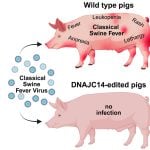It’s fall, and time to think about how well you controlled herbicide-resistant weeds this season, and to plan your strategy for the next.

“Many farmers in Ontario had herbicide-resistant Canada fleabane in their fields in 2022,” says Bayer Market Development Manager Adam Pfeffer. “It’s the most widespread herbicide-resistant weed in the province, but the very serious issue of glyphosate-resistant waterhemp is on the rise in Ontario, Quebec and Manitoba as well.”
Pfeffer says this weed is “going to steamroll farmers” unless they are very careful.
“If it goes to seed in your fields, you are in for a career of difficulty managing it. I farm as well in the St. Thomas region in Elgin County and it’s my number one concern.”
In May, Peter Sikkema, professor of Field Crop Weed Management at University of Guelph, reported on Twitter that “there are 15 counties in Ontario with multiple-herbicide-resistant waterhemp. Two counties have three-way resistance, six counties have four-way resistance, and seven counties have five-way resistance.”
Pfeffer says the populations with five-way resistance are resistant to Groups 2, 5, 9, 14 and 27.
“This weed is a very serious problem for a few reasons besides how prone it is to developing herbicide resistance,” he explains. “It emerges throughout the season, so you need to put your best foot forward with your choice of soybean seed and your first pass of herbicide. Waterhemp germinates every week from the first week of April into October and two-inch plants can produce viable seeds.”
For control, Pfeffer encourages using XtendFlex® soybeans, which provide tolerance to three modes of action – dicamba, glyphosate and glufosinate. “There are two use options – utilize an effective residual herbicide pre-emerge along with dicamba or use dicamba in the V2 stage after the pre-emerge residual and a third pass of Liberty at R1 to see the best results.”
Pfeffer says we can’t talk enough about herbicide-resistant waterhemp, which is already causing problems in several Ontario fields. XtendFlex soybeans offer control before the problems get out of hand.
“Because XtendFlex soybeans have tolerance to three herbicides, they give farmers flexibility in herbicide choice while also providing the high-yielding performance they need — the same great-yielding soybeans (Roundup Ready 2 Xtend® soybean genetics) that they know and trust, now with the added benefit of glufosinate tolerance.”
Triple tolerance
XtendFlex soybeans were introduced to the Canadian market in January 2021, the latest addition to the Roundup Ready® Xtend Crop System. XtendFlex trait technology gives soybeans tolerance to glyphosate, dicamba and glufosinate (Liberty), so farmers can choose the herbicide combination that best suits their operation and weed spectrum.
“With XtendFlex, farmers can keep dicamba (first pass, high rate) to their first herbicide pass and achieve early control of weeds such as waterhemp, Canada fleabane, lamb’s-quarters, redroot pigweed and common ragweed,” says Pfeffer. “It allows you to get ahead and stay ahead. With XtendFlex soybeans having glufosinate tolerance, you also have the added flexibility for another non-selective post-emergent application option like Liberty.”
For first-pass, high-rate dicamba options, both XtendiMax® 2 herbicide with VaporGrip® Technology (a low-volatility dicamba formulation) and Roundup Xtend® 2 herbicide with VaporGrip® Technology (an easy-to-use, pre-mixed combination of low-volatility dicamba and glyphosate) provide short term residual activity to keep fields clean longer.
Pfeffer also advises upgrading spray nozzles to ultra-coarse spray quality and using the Spray Forecast® tool to determine when spray conditions are favourable in XtendFlex soybean fields. For a full list of practices, including correct spray nozzles and application window guidelines, visit the Application Guidelines page.
Farmers with FieldViewTM can also keep a permanent record of conditions at time of spraying.
“Ideally, you’ll be able to use your previous years’ scouting reports with ‘pins’ in FieldView marking the location of weed hotspots in your XtendFlex soybeans fields to help with future management,” says Pfeffer. “Waterhemp and Canada fleabane are two of the weeds we need to keep a particular eye on in 2023, but XtendFlex gives growers options and flexibility for weed control in 2023.”
Pfeffer says the availability and acreage of XtendFlex soybeans continue to expand and they are now available from several seed distributors. He says it’s particularly popular with farmers who want to plant soybeans in fields around greenhouses and urban areas where Group 4 chemistry is more challenging.
“It gives us three modes of action, which will help keep herbicide-resistant weeds like Canada fleabane and waterhemp under control. Remember that in XtendFlex soybeans, first pass, high rate of dicamba is your first step. We have that knock-down capability, but we may need to do more control in second pass, and these soybeans give you flexibility with that.”
Bayer is a member of Excellence Through Stewardship® (ETS). Bayer products are commercialized in accordance with ETS Product Launch Stewardship Guidance, and in compliance with Bayer’s Policy for Commercialization of Biotechnology-Derived Plant Products in Commodity Crops. These products have been approved for import into key export markets with functioning regulatory systems. Any crop or material produced from these products can only be exported to, or used, processed or sold in countries where all necessary regulatory approvals have been granted. It is a violation of national and international law to move material containing biotech traits across boundaries into nations where import is not permitted. Growers should talk to their grain handler or product purchaser to confirm their buying position for these products. Excellence Through Stewardship® is a registered trademark of Excellence Through Stewardship.
ALWAYS READ AND FOLLOW PESTICIDE LABEL DIRECTIONS. It is a violation of violation of federal law to use any pesticide product other than in accordance with its labeling. NOT ALL formulations of dicamba, glyphosate or glufosinate are approved for in-crop use with products with XtendFlex® Technology. ONLY USE FORMULATIONS THAT ARE SPECIFICALLY LABELLED AND APPROVED FOR SUCH USES. Contact the Pest Management Regulatory Agency with any questions about the approval status of dicamba herbicide products for in-crop use with Roundup Ready 2 Xtend® soybeans or products with XtendFlex® Technology.
Products with XtendFlex® Technology contains genes that confer tolerance to glyphosate, glufosinate and dicamba. Glyphosate will kill crops that are not tolerant to glyphosate. Dicamba will kill crops that are not tolerant to dicamba. Glufosinate will kill crops that are not tolerant to glufosinate. Contact your Bayer retailer, refer to the Bayer Technology Use Guide, or call the technical support line at 1-888-283-6847 for recommended Roundup Ready® Xtend Crop System weed control programs.
Roundup Ready 2 Xtend®, Roundup Ready 2 Yield®, Roundup Ready® and XtendFlex® are registered trademarks of Bayer Group. Used under license. LibertyLink and the Water Droplet Design are trademarks of BASF. Used under license. ©2022 Bayer Group. All rights reserved.










